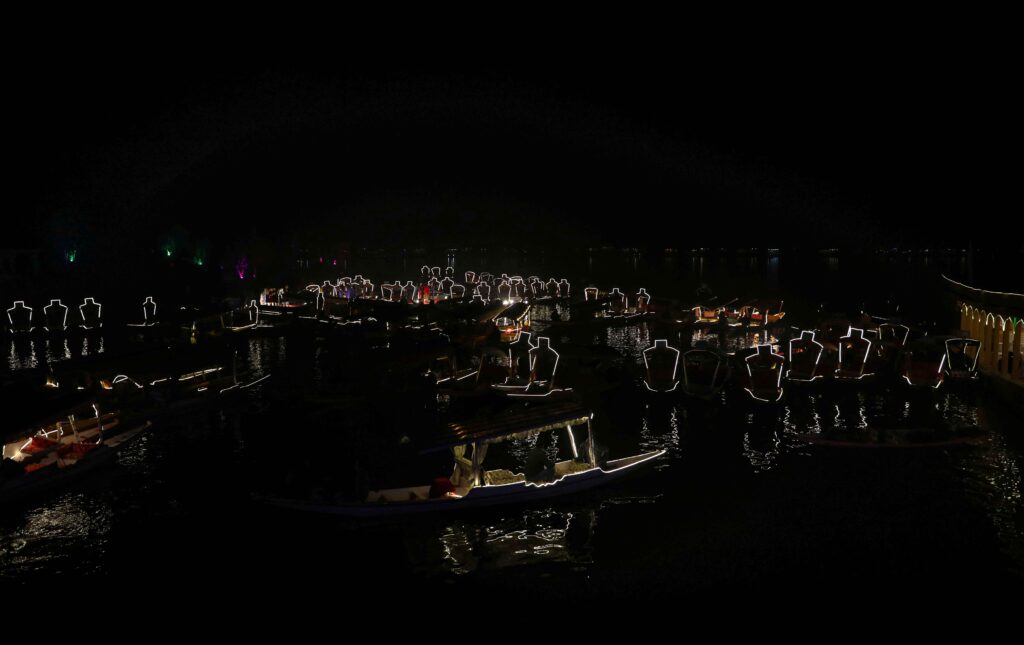The history of the Kashmiri houseboats dates back to the 19th century.
Jaspreet Kaur
The houseboats of Kashmir are famous for their unique and rich designs and hospitality and they attract a number of tourists from across the globe. There are about 950 houseboats in Dal and Nigeen lakes.
To celebrate the uniqueness of this floating marvel, the Department of Tourism celebrated a two-day ‘Houseboat Festival’ earlier this month, originally scheduled for September, 2022. The previous houseboat festival was organized in October 2021 as part of the Iconic Week Festivals.

During the two day festival inaugurated by J&K Lt Governor Manoj Sinha, emphasis was laid on the heritage value of the houseboats on these two lakes. The festival featured a floating stage, live music, and cultural events, art exhibition, besides showcasing of varied culinary and cuisine specialities. Illuminated houseboats and laser light show were also part of the festival. Music included traditional folk music with live performances by local bands. Other activities included screening of iconic films and documentaries depicting Kashmiri culture, heritage on floating cubical screens in the Dal waters, 3D laser show and water screen, displaying of documentaries regarding houseboats of Kashmir, visit to the backwaters of Dal lake and exhibition of local handicrafts.

According to Director Tourism Kashmir, Fazlul Haseeb, the festival was organised as the houseboats have played a unique role in attracting tourists from across the globe and are being promoted as this winter season’s main attraction. A record number of over two million tourists visited Kashmir this year so far and the houseboats in Dal and Nigeen lakes witnessed 80-90 per cent occupancy this year. However, with the onset of winter and cold weather conditions, the occupancy has dropped in the houseboats to 20-30%. The message that the Director Tourism wants to send through the Houseboat Festival is that that ‘Kashmir is truly warm in winters as well’. However, the houseboat owners feel that the festival would have been more fruitful had it been organized earlier in October.

Glittering Shikaras over the Dal lake with Zabarwan hills in the background amid minus-degree temperatures is a view that can only be witnessed in Kashmir. Houseboats which are generally fully booked in summer are for the first time preparing to host guests during the winter season.
The main purpose was not to just show the houseboats but the whole of Kashmir for the winter season. Such as ski courses, not only in Gulmarg but also in Yusmarg, Sonmarg, Pahalgam and Doodhpathri. Pahalgam is also going to remain open to the tourists in winter.
Shikaras were also a major attraction of the festival. A shikara is a type of wooden boat found on Dal Lake and other water bodies of Srinagar in Jammu and Kashmir. Shikaras are of various sizes and are used for multiple purposes, including transportation. A usual shikara seats six people, with the driver paddling at the rear. Like the Venetian gondolas, they are a cultural symbol of Kashmir. Some shikaras are used for fishing, harvesting aquatic vegetation (usually for fodder) and transport, while most are covered with tarpaulins and are used to ferry tourists. Some are also used as floating shops.
The craft relies on deodar wood (which does not decompose in water) ranges from 25 to 41 feet in length. The pointed front end is followed by a central section made of 8 planks of wood and the boat eventually ends in a flat rear segment. Two planks of wood lend to each of the side elevations a vertical height of 1.5 feet. It has a conspicuous spade shaped base.
The nails and iron clamps used for joinery are flush and fixed into the wood diagonally when they are red hot, to ensure stronger bonding. Care is taken to keep them hidden for the visual aesthetics of the boat. Caulking uses a paste containing poplar seed. The boat is created over 10 to 12 days.
Seating arrangements are organized in the central segment of the boat by positioning cushions and related upholstery over the built-in storage space underneath. A canopy is supported on four pillars. The centre and the ends are equipped with iron anchor rings and wooden pegs, which are used to fasten the shikara on the banks of the lake. The shikaras are eventually painted in bright colors and may further be polished, engraved and embellished.
The history of the Kashmiri houseboats dates back to the 19th century and in the earlier days, they were used more for personal use and not for tourism. It was a daily style of living among the people who built boats to live on the lake. In the early days, only British officials of the East India Company were allowed to build and stay in the houseboats as the Maharaja of Jammu and Kashmir did not allow the British to buy property. Today, there are nearly a thousand houseboats in the Kashmir valley and most of them are used for tourism purposes.
The Kashmiri houseboats are floating houses that are anchored along the banks of some of the most beautiful lakes. The houseboats are like a blend of hotel and homestay on the water. The houseboats have been crafted with great care and are adorned with intricate woodwork that displays the exquisite art and fine craftsmanship of Kashmiri artisans.
In the late 19th century, the boat-dwelling hanji community of Srinagar started building floating homes or houseboats for English visitors and residents, who were not allowed to own land in Kashmir.

Some specifically trace the houseboat phenomenon to around the 1880s to a shop owner, Pandit Naraindas, who used to cater to foreign tourists. When his shop burnt down, as wooden structures in Srinagar are wont to from time to time, it is said that Naraindas moved his inventory to a small boat used by the boat-dwelling hanjis and moored it. With some improvements, his became the first proper houseboat. Later, Naraindas sold his boat to a European, realised the potential in the idea, and started commissioning boats. He became locally famous as ‘Naav Narain’ and his first houseboat was named Kashmir Princess.
However, British explorer Sir Francis Younghusband is known to have credited one MT Kennard with the idea of a floating house between the years 1883 and 1888. It is said that for a long time locals used to call these ‘the boats of Kennad Sahib’. Younghusband wrote that, by 1906, there were hundreds of houseboats in Kashmir.
The early European boats were called HB Duke Wells, or New Buckingham Palace, in honour of the settler’s memories and sensibilities. These houseboats now have fancy names inspired by Hollywood, Bollywood and names of celebrities.
Jaspreet Kaur is a New Delhi-based architect and urban designer. She is the trustee of Lymewoods and Span Foundation.


